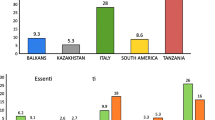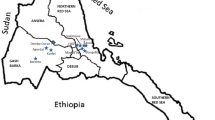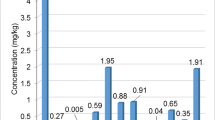Abstract
Honey is a common sweetener in the Jordanian diet with an annual consumption of approximately one thousand tons, two-thirds of which are imported. It is believed that the elemental profile of honey is an indicator of safety and botanical and geographic origin. In the literature, there are a lack of studies concerning the levels of major and trace elements in honey in Jordan. A total of 46 elements, including 15 rare earth elements (REEs), were analyzed by inductively coupled plasma-mass spectrometry (ICP-MS) in 18 monofloral and multifloral imported honey samples and 12 multifloral local samples. Regarding monofloral samples, Black Forest samples had the highest total metal content, while acacia samples had the lowest total metal content. Local multifloral honey had the largest Sr and total REE levels, while it had the lowest Mn levels. Very low levels of toxic elements were found in all samples, indicating the safety of honey in Jordan for human consumption. The results of this study showed that a large number of samples (> 100) and the application of advanced statistical models are required to discriminate between multifloral imported and local honey.
Similar content being viewed by others
Data availability
All data generated or analyzed during this study are included in the published article and its supplementary information files.
References
Adugna E, Hymete A, Birhanu G, Ashenef A (2020) Determination of some heavy metals in honey from different regions of Ethiopia. Cogent Food Agric 6:1764182. https://doi.org/10.1080/23311932.2020.1764182
Aghamirlou HM, Khadem M, Rahmani A, Sadeghian M, Mahvi AH, Akbarzadeh A, Nazmara S (2015) Heavy metals determination in honey samples using inductively coupled plasma-optical emission spectrometry. J Environ Health Sci Eng 13:1–8. https://doi.org/10.1186/s40201-015-0189-8
Al-Eisawi (1982) List of Jordan vascular plants. Botanische Staatssammlung Munchen 18:79–182
Al-Eisawi (1985) Vegetation in Jordan. In: Hadidi A (ed) Studies in history and archology of Jordan. Routledge & Kegan Paul, London, pp 45–58
Al-Eisawi (1996) Vegetation in Jordan II. UNESCO, Cairo Office
Al-Eisawi (1998) Field guide to wild flowers of Jordan and neighboring countries. Jordan Press, Amman, pp 1–18
Alvarez-Suarez JM, Tulipani S, Romandini S, Bertoli E, Battino M (2010) Contribution of honey in nutrition and human health: a review. Med J Nutrition Metab 3:15–23. https://doi.org/10.1007/s12349-009-0051-6
Anklam E (1998) A review of the analytical methods to determine the geographical and botanical origin of honey. Food Chem 63:549–562. https://doi.org/10.1016/S0308-8146(98)00057-0
Ball DW (2007) The chemical composition of honey. J Chem Educ 84:1643–1646. https://doi.org/10.1021/ed084p1643
Berriel V, Barreto P, Perdomo C (2019) Characterisation of Uruguayan honeys by multi-elemental analyses as a basis to assess their geographical origin. Foods 8(1):24. https://doi.org/10.3390/foods8010024
Bilandžić N, Tlak Gajger I, Kosanović M, Čalopek B, Sedak M, Solomun Kolanović B, Varenina I, Luburić ĐB, Varga I, Đokić M (2017) Essential and toxic element concentrations in monofloral honeys from southern Croatia. Food Chem 234:245–253. https://doi.org/10.1016/j.foodchem.2017.04.180
Cantarelli MA, Pellerano RG, Marchevsky EJ, Camiña JM (2008) Quality of honey from Argentina: study of chemical composition and trace elements. J Argent Chem Soc 96(1):33–41
Conti ME, Canepari S, Finoia MG, Mele G, Astolfi ML (2018) Characterization of Italian multifloral honeys on the basis of their mineral content and some typical quality parameters. J Food Compos Anal 74:102–113. https://doi.org/10.1016/j.jfca.2018.09.002
Czipa N, Andrási D, Kovács B (2015) Determination of essential and toxic elements in Hungarian honeys. Food Chem 175:536–542. https://doi.org/10.1016/j.foodchem.2014.12.018
De Alda-Garcilope C, Gallego-Picó A, Bravo-Yagüe JC et al (2012) Characterization of Spanish honeys with protected designation of origin “miel de Granada” according to their mineral content. Food Chem 135:1785–1788. https://doi.org/10.1016/j.foodchem.2012.06.057
de Oliveira FA, de Abreu AT, de Oliveira NN et al (2017) Evaluation of matrix effect on the determination of rare earth elements and As, Bi, Cd, Pb, Se and In in honey and pollen of native Brazilian bees (Tetragonisca angustula – Jataí) by Q-ICP-MS. Talanta 162:488–494. https://doi.org/10.1016/j.talanta.2016.10.058
Devillers J, Doré JC, Marenco M, Poirier-Duchêne F, Galand N, Viel C (2002) Chemometrical analysis of 18 metallic and nonmetallic elements found in honeys sold in France. J Agric Food Chem 50:5998–6007. https://doi.org/10.1021/jf020497r
Drivelos SA, Danezis GP, Halagarda M, Popek S, Georgiou CA (2021) Geographical origin and botanical type honey authentication through elemental metabolomics via chemometrics. Food Chem 338:127936. https://doi.org/10.1016/j.foodchem.2020.127936
Gallmann P (2007) Minerals in honey: environmental, geographical and botanical aspects. J Apic Res:269–275. https://doi.org/10.3896/ibra.1.46.4.11
Grembecka M, Szefer P (2013) Evaluation of honeys and bee products quality based on their mineral composition using multivariate techniques. Environ Monit Assess 185:4033–4047. https://doi.org/10.1007/s10661-012-2847-y
Hernández OM, Fraga JMG, Jiménez AI, Jiménez F, Arias JJ (2005) Characterization of honey from the Canary Islands: determination of the mineral content by atomic absorption spectrophotometry. Food Chem 93:449–458. https://doi.org/10.1016/j.foodchem.2004.10.036
Jordan's 2019 honey production surpassed yearly average. Jordan Times; 2019: Feb 5.
Jurowski K, Szewczyk B, Nowak G, Piekoszewski W (2014) Biological consequences of zinc deficiency in the pathomechanisms of selected diseases. J Biol Inorg Chem 19:1069–1079. https://doi.org/10.1007/s00775-014-1139-0
Jurowski K, Krośniak M, Fołta M, Tatar B, Cole M, Piekoszewski W (2019a) The analysis of Cu, Mn and Zn content in prescription food for special medical purposes and modified milk products for newborns and infants available in Polish pharmacies from toxicological and nutritional point of view. J Trace Elem Med Biol 53:144–149. https://doi.org/10.1016/j.jtemb.2019.03.001
Jurowski K, Krośniak M, Fołta M, Tatar B, Cole M, Piekoszewski W (2019b) Safety assessment of the trace element impurities Ni and Cr in pharmaceutical herbal products for teething from Polish pharmacies. Biol Trace Elem Res 191:517–521. https://doi.org/10.1007/s12011-019-1643-8
Kiliç Altun S, Dinç H, Paksoy N et al (2017) Analyses of mineral content and heavy metal of honey samples from south and east region of Turkey by using ICP-MS. Int J Anal Chem 2017:1–6. https://doi.org/10.1155/2017/6391454
Lazarević KB, Andrić F, Trifković J, Tešić Ž, Milojković-Opsenica D (2012) Characterisation of Serbian unifloral honeys according to their physicochemical parameters. Food Chem 132:2060–2064. https://doi.org/10.1016/j.foodchem.2011.12.048
Maione C, Barbosa F, Barbosa RM (2019) Predicting the botanical and geographical origin of honey with multivariate data analysis and machine learning techniques: a review. Comput Electron Agric 157:436–446. https://doi.org/10.1016/j.compag.2019.01.020
Dominguez A, Paz S, Rubio C, Gutièrrez Á, González-Weller D, Revert C, Hardisson A (2017) Essential and toxic metals in infant formula from European community. Open Access J Toxicol 2(2). https://doi.org/10.19080/OAJT.2017.02.555585
Rashed MN, Soltan ME (2004) Major and trace elements in different types of Egyptian mono-floral and non-floral bee honeys. J Food Compos Anal 17:725–735. https://doi.org/10.1016/j.jfca.2003.10.004
Ru QM, Feng Q, He JZ (2013) Risk assessment of heavy metals in honey consumed in Zhejiang province, southeastern China. Food Chem Toxicol 53:256–262. https://doi.org/10.1016/j.fct.2012.12.015
Salvador L, Guijarro M, Rubio D, Aucatoma B, Guillén T, Vargas Jentzsch P, Ciobotă V, Stolker L, Ulic S, Vásquez L, Garrido P, Bravo J, Ramos Guerrero L (2019) Exploratory monitoring of the quality and authenticity of commercial honey in Ecuador. Foods 8:1–13. https://doi.org/10.3390/foods8030105
Solayman M, Islam MA, Paul S, Ali Y, Khalil MI, Alam N, Gan SH (2016) Physicochemical properties, minerals, trace elements, and heavy metals in honey of different origins: a comprehensive review. Compr Rev Food Sci Food Saf 15:219–233. https://doi.org/10.1111/1541-4337.12182
Spiric D, Ciric J, Teodorovic V, Nikolic D, Nikolic A, Radicevic T, Jankovic S (2019) Trace elements and heavy metals in multifloral honeys from Serbia. IOP Conf Ser Earth Environ Sci 333 012104: https://doi.org/10.1088/1755-1315/333/1/012104
Squadrone S, Brizio P, Stella C et al (2020a) Minerals in honey: environmental, geographical and botanical aspects. Foods 8:1–13. https://doi.org/10.3896/ibra.1.46.4.11
Squadrone S, Brizio P, Stella C, Pederiva S, Brusa F, Mogliotti P, Garrone A, Abete MC (2020b) Trace and rare earth elements in monofloral and multifloral honeys from Northwestern Italy; a first attempt of characterization by a multi-elemental profile. J Trace Elem Med Biol 61:126556. https://doi.org/10.1016/j.jtemb.2020.126556
Squadrone S, Brizio P, Stella C, Mantia M, Pederiva S, Brusa F, Mogliotti P, Garrone A, Abete MC (2020c) Trace elements and rare earth elements in honeys from the Balkans, Kazakhstan, Italy, South America, and Tanzania. Environ Sci Pollut Res 27:12646–12657. https://doi.org/10.1007/s11356-020-07792-7
Tahboub YR, Massadeh AM, Al-sheyab NA, El sharfat D, Nsserat IA (2021) Levels of trace elements in human breast milk in Jordan: a comparison with infant formula milk powder. Biol Trace Elem Res https://doi.org/10.1007/s12011-020-02547-4
Wetwitayaklung P, Wangwattana B, Narakornwit W (2018) Determination of trace-elements and toxic heavy minerals in Thai longan, litchi and Siam weed honeys using ICP-MS. Int Food Res J 25:1464–1473
World Health Organization (2017) Guidelines for drinking-waterquality. https://apps.who.int/iris/handle/10665/254637
Zaitoun ST, Al-Ghzawi AM, Shannag HK (2000) Population dynamics of the Syrian honeybee, Apis mellifera syriaca, under semi-arid mediterranean conditions. Zool Middle East 21:129–132. https://doi.org/10.1080/09397140.2000.10637839
Zhou X, Taylor MP, Salouros H, Prasad S (2018) Authenticity and geographic origin of global honeys determined using carbon isotope ratios and trace elements. Sci Rep 8:1–11. https://doi.org/10.1038/s41598-018-32764-w
Acknowledgements
This project was funded by the Deanship of Scientific Research at Jordan University of Science and Technology. ICP-MS analysis was performed at Jordan Atomic Energy Commission (JAEC) laboratories. The authors would like to thank Dr. Hanan Hammouri from Department of Mathematics and Statistics at Jordan University of Science and Technology for valuable help in the statistical analysis. Additionally, we would like to thank all who participated in this research and provided honey samples.
Funding
This research was funded by the Deanship of Scientific Research-Jordan University of Science and Technology (Project n. 625/2016).
Author information
Authors and Affiliations
Contributions
The authors contributed to this research in the following manner. Y. Tahboub and A. Al-Ghzawi supervised all stages from the collection of samples to the writing of the manuscript. S. Al-Zayadneh and M. AlGhotani validated the methods and performed elemental analysis.
Corresponding author
Ethics declarations
Ethics approval
Not applicable
Consent to participate
Not applicable
Consent for publication
Not applicable
Competing interests
The authors declare no competing interests.
Additional information
Responsible Editor: Philippe Garrigues
Publisher’s note
Springer Nature remains neutral with regard to jurisdictional claims in published maps and institutional affiliations.
Rights and permissions
About this article
Cite this article
Tahboub, Y.R., Al-Ghzawi, A.AM.A., Al-Zayafdneh, S.S. et al. Levels of trace elements and rare earth elements in honey from Jordan. Environ Sci Pollut Res 29, 11469–11480 (2022). https://doi.org/10.1007/s11356-021-16460-3
Received:
Accepted:
Published:
Issue Date:
DOI: https://doi.org/10.1007/s11356-021-16460-3




